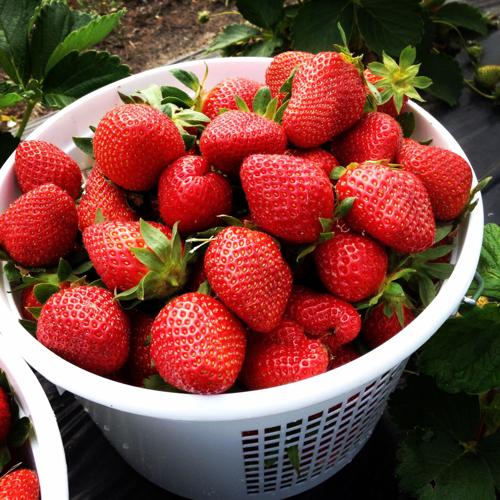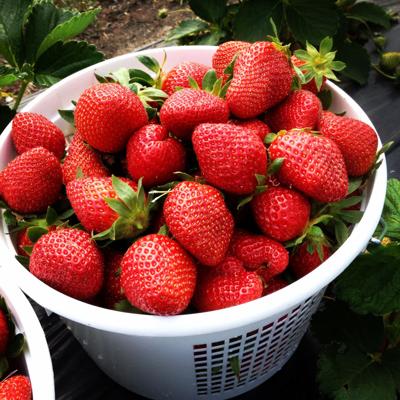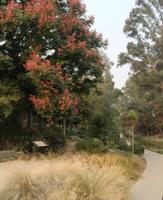One of the most popular fresh fruits in the United States, strawberries are a fragrant and sweet fruit with a multitude of nutritional benefits.
Now is the best time to get started growing these wonderful plants in the home garden.

This strawberry has an unusual shape. Provided/Zachary Snipes
Contrary to the name, though, the strawberry is not a true berry but an aggregate fruit in which the tiny, one-seeded achenes are located on the fleshy receptacle, the part we enjoy.
They are members of the Rosaceae (Rose) family, which includes blackberries and raspberries. While the majority of strawberries in the United States are grown in California, South Carolina grows hundreds of acres each year. Strawberries can be grown throughout the state, and there many local growers providing excellent sources of the fresh fruit.
Strawberries have been described in history and literature since Ancient Rome. And while these strawberries are often described as being symbols of love and purity, they differ greatly from the wonderful fruit we enjoy today.
History of strawberry
Strawberry production is relatively new in terms of food production, but the plant has a fascinating history.
The strawberry described throughout much of history is either a wild strawberry or an ornamental fruit that was not eaten. Both the wood strawberry (Fragaria vesca) and the musky strawberry (F. moschata) were wild species that were eventually cultivated in European gardens.

Strawberry plants produce flowers that can have five to eight petals and come in different colors. Provided/Zachary Snipes
Native Americans were already using strawberries when English colonists arrived. But they were using the Virginia strawberry (F. virginiana). It was not until the introduction of the Chilean strawberry (F. chiloensis), a wild species with much larger fruit, did the modern strawberry come about.
When the French accidentally crossed the two new world strawberry species, the world was given the wonderful modern strawberry (F. x ananassa).
Strawberries can be grown easily in the home garden setting with proper preparation and care. The plants require plenty of sunlight for a good crop and are a shallow-rooted plant that grow best with well-drained, fertile soil.
Select an appropriate site for growing. It is best to have a soil test done before planting to determine the soil pH and fertilizer needs. This is important for better production of fruit.
The preferred soil pH of strawberries is 6.0 to 6.5. Since the modern strawberry is a hybrid, plants are started through the planting of crowns. Strawberry plants produce runners that will root naturally, producing the crowns, which can be taken and planted as a new plant.
Growing methods
There are two main methods of growing strawberries: the matted row method and the annual hill method.
The matted row method is a perennial system. The crowns are planted in the first spring and then produce in the second spring. While this system may work in certain areas, it is difficult to maintain here in the Lowcountry due to pest and disease issues, especially anthracnose, which is a fungal disease that is difficult to control.

These strawberry plants are grown in raised beds. Provided/Zachary Snipes
The best method for this area is the annual hill method, in which crowns are planted during the fall and fruit are harvested in the spring. This requires a raised mound in which plants are spaced 12 inches apart in two rows, also 12 inches apart.
There are two main types of strawberries, June-bearing and everbearing cultivars. While both will grow here, June-bearing strawberry cultivars are best suited for South Carolina and should be selected for local gardens.
June-bearing cultivars produce abundantly for three to four weeks, making them ideal for annual hill planting. Everbearing cultivars produce for longer periods but in smaller quantities and thrive more in cooler climates. Everbearing cultivars may work for matted-hill production.
Whichever system is used, be sure to start with disease-free crowns and maintain proper water and fertilizer for the best production.
Water is especially key during both establishment and during flowering and fruit set. Fertilize based on the soil test done for best results. Apply a preplant fertilizer before planting to help establishment and side dress with nitrogen as the plants grow to ensure healthy, vigorous plants.
If properly cared for, plants should be ready to harvest at the end of March.
Pests and diseases
There are some pests and diseases to watch out for that can be detrimental to the plant.

A strawberry is affected by Botrytis fruit rot. Provided/Zachary Snipes
Diseases can be a serious issue and are the biggest limiting factor for producing strawberries here in the Lowcountry.
There are important diseases to be careful of such as anthracnose and Botrytis fruit rot.
To reduce the incidence of these diseases, use the annual hill method of planting as well as practice good sanitation techniques such as the removal of any diseased fruits or leaves.
Also, be sure to select disease resistant cultivars before planting.
For more information about strawberry planting or selecting cultivars, go to Clemson’s Home and Garden Information Center for various factsheets on strawberries: https://hgic.clemson.edu/.















